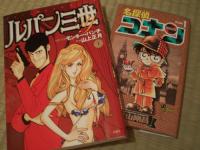Sorry for the sparse blogging as of late (I know: piccies don’t count). I’ll just leave it up to you to pull the appropriate form RFC-3563 (a.k.a. “I’m sorry I did’t blog for so long. Here are the reasons why…”) and fill it with whatever you fancy.
In order to break the silence, I am not gonna rant about spitefully incompetent French university personnel, nor am I gonna express any sort of opinion about the current bouts of suburban pyromania taking place one hour north of the city I’m moving to next month (oh no, we aren’t talking about that. keep walking. keep walking. just a bit more… yep, good).
Instead, I’m gonna give you the detailed recipe for the most amazing Japanese dish you’ve ever had. And not only is it yumtastic, but it’s also dirt-easy to make and vegetarian. If you’ve lived in Japan any, you probably know about the difficulties of following a vegetarian diet in this beautiful country. In fact, if you meet somebody here who tells you he is a die-hard vegetarian, he is most likely either a liar, an imbecile or eating the vast majority of his meals at home (I know a couple of the latter). Oddly enough for a somewhat buddhist country, the concept of vegetarianism is about as foreign to Japan as it is to your average midwest eatery (where asking for a vegetarian meal means you want a side order of fries with your 3-pound rib-eye steak). No matter how hard you try, and even after you’d eventually manage to convey the idea that neither chicken skin nor seafood could reasonably be considered “vegetables”, the ubiquitous fish-sauce that’s added to about any edible dish in Japan will get you in the end.
Luckily, I was never the religious veggie type: I did not eat meat or fish during my last few years living in SF, but it was mostly by choice of a health-conscious diet, not the deep-seated conviction that I would be snacking on the reincarnation of my grandpa. While not a deciding factor, the fact that my dearly beloved was a veggie herself helped a lot… Not that she would impose it on me or anything, but it just makes things infinitely easier when you don’t have to cook two of each meals you take together…
And overall, SF might be one of, if not the, most herbivore friendly cities in the world, where opening a restaurant without at least a few decent vegetarian dishes on the menu is akin to commercial suicide.
Yet, I was never hardcore and had no qualms about ever so occasionally partaking in some delicious late-night cheeseburger goodness. What can I say: In-N-Out burgers are like the choir boys of vegetarian priesthood… It’s just impossible to resist.
So upon moving to Tokyo, I quickly decided to spare many an awkward encounters with flustered Japanese restaurant employees by accommodating whatever was on the menu and keeping my vegetarian tendencies for home-cooking. Though even this isn’t quite as easy here as in sunny California, considering the substantial difference in availability and pricing for fresh groceries that do not contain tentacles or miscellaneous animal parts.
A man needs his calories, especially in Japan, and there are only so many ways you can cook tofu before getting seriously tired of it. Let’s face it, tofu is quite bland, edible at best (granted there is a world of difference between what you’ll get in a supermarket and what I can buy at the Tofu-ya just down the road), hardly anywhere as exciting as, say, a crispy strip of bacon. Unless… Unless…
Unless you make:
Agedashi Tofu (揚げ出し豆腐)
This amazing recipe will single-handedly revert any misguided aversion you may have toward eating coagulated rotten soy beans, or as we like to call it around here: tofu. It draws its powers from an ancient and revered cooking technique, one that holds the magical property of turning any semi-edible piece of junk into sin-inducing candy goodness: deep frying.
Some of our readers are no doubt familiar with this staple of fair food in the UK: deep-fried Snickers chocolate bars (or its Kentucky’s US equivalent: deep-fried squirrel balls) and its much improved yummy-factor as a result. Well, tofu works the same: the technique will turn an overall unappetizing lump of healthy proteins into a much-less-healthy, but infinitely more sexy, golden tofu beignet, whose creamy inside will melt on your tongue. Add to it our patented Magical All-purpose Japanese Sauce™ (sold separately, see details on top), and you have yourself a strong contender for best Japanese food, on a tight spot with Shoyū Ramen.
Convinced now?
On to cooking then:
